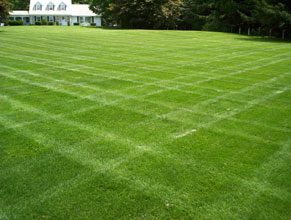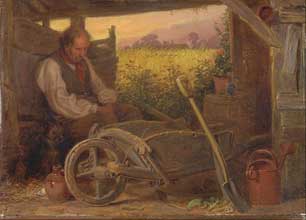 What is the most mollycoddled plant in these United States? On which plant do we spend the most time and money encouraging it to grow, only to regularly whack it down? You’re getting warm. What plant do we allow to grow brown and ugly for months every year, and yet we keep it? You’re almost there. What plant covers more acreage in the U.S. than any agricultural crop? Maybe all agricultural crops combined?
What is the most mollycoddled plant in these United States? On which plant do we spend the most time and money encouraging it to grow, only to regularly whack it down? You’re getting warm. What plant do we allow to grow brown and ugly for months every year, and yet we keep it? You’re almost there. What plant covers more acreage in the U.S. than any agricultural crop? Maybe all agricultural crops combined?
You guessed it. Turf. Lawn. Grass. Sod. And it’s the biggest single user of water in the whole United States, by far. Considering that water may become more expensive than gasoline in the not too distant future, we should do something about it, don’t you think?
Lawns aren’t new. They probably stemmed from the treeless expanses of grass which grew naturally in the savannahs of Africa, and enabled the first primitive humans to see the advancing menace of other tribes or dangerous animals. Treeless areas in Europe were cultivated around early castles and manor houses; useful for the same reasons as the African savannahs.
Even after the danger of wild animals and marauding enemies was over, vast estate lawns were maintained by serfs with scythes or by grazing animals. Land was too precious for anyone but the rich to use for anything but for growing food. Lawns became status symbols, which were brought to the New World by immigrants, along with the seeds to plant them.
However, it wasn’t until after the Civil War that land surrounding ordinary homes and homesteads was used for ornamental purposes. Even then, ornamental use was mostly limited to a few flowers and shrubs.
Everything changed in 1830 with the invention of the first mechanical device to mow lawns. It enabled parks to devote large expanses of turf to recreational purposes and sports. By 1890, lawn mowers were more affordable and homes began to sprout front yards with lawns.
With the advent of subdivisions to provide housing for returning veterans of World War II, every new development house had a lawn. From the 1950’s on, lawns were almost the exclusive province of the male homeowner, and his status in the community was often based on the beauty of his lawn. It must be that “Y” chromosome thingy.
Every decade since the 50s has produced new advancements in lawn management. Sod farms, lawn ‘sprinklers’, then automatic irrigation systems. Power and riding mowers became more affordable. As America’s economy improved, lawn maintenance companies proliferated. *As of May 2019, landscaping services alone generated revenue of almost a hundred billion dollars. Chemical companies introduced more and more chemicals to help your lawn grow faster and grow weed and disease free. Entire sections of box stores are devoted to lawn care. Outdoor use of water continues to rise. In 2015, it was 7 billion gallons per day. In 2018, it increased to 9 billion gallons per day. Every day.
Where will it all end? It appears it’s not going to end anytime soon. Many homeowners’ associations still actually require that a certain amount of your property be devoted to turf. And so far, I’ve haven’t seen a single new home built without a lawn area.
Environmentalists are making progress, though. Xeriscaping (limited water use gardening) is becoming more popular. If more states such as California legally limit irrigation use, homeowners will begin to seek out ways other than lawns to enhance their property.
One of the most environmentally responsible things we can do is re-program our irrigation systems, or better yet, stop using the automatic feature and water only when your lawn actually needs it. Otherwise, make sure your system has a rain sensor and be sure it’s working. Frequent, shallow irrigation is bad for your lawn and bad for your pocketbook. The roots will stay near the surface where the livin’ is easy and will always be water hungry. Except in extended periods of heat and drought, properly conditioned lawns should get by with a good drenching once or twice a week.
Just a hint – don’t use ‘Weed and Feed’ products. They won’t actually hurt anything, but it’s a waste of money. Fertilizers and weed control products should be applied at different times. Pre-emergence products to control weeds should be applied in February. Fertilizer should not be used until the grass has greened up. And use both sparingly. Centipede grass is often called the “poor man’s grass’ because it actually thrives in lean soil. Lowcountry soil is usually loaded with phosphorus (the middle number on fertilizer labels), so look for fertilizers labeled 15-0-15. Just to be sure, you should get a soil test.
Think seriously about reducing the size of your lawn. Even just a few square feet. Every little bit will help.
Personally, I’m thinking about buying a lot of green spray paint. As my mother would say, “A man on a fast horse would never notice.”
*https://www.statista.com/statistics/294212/revenue-of-landscaping-services-in-the-us/








